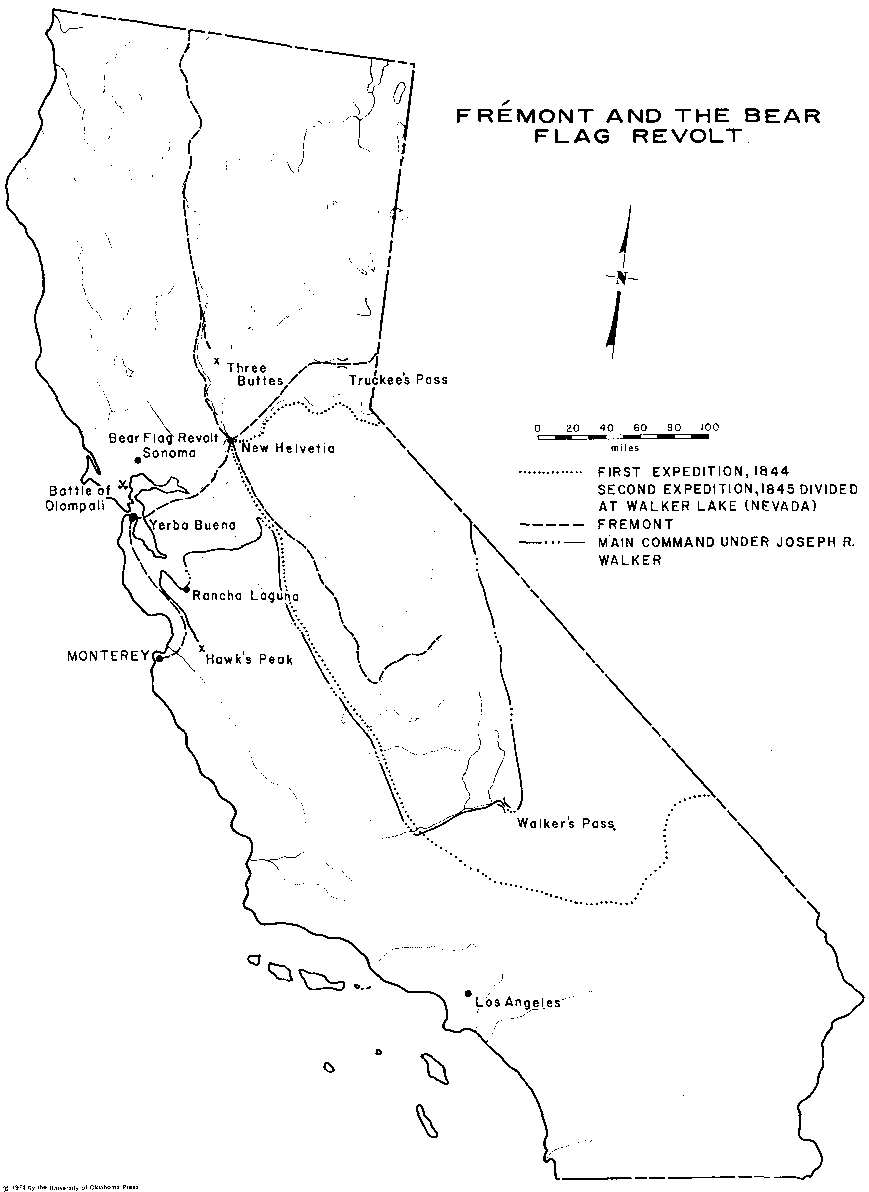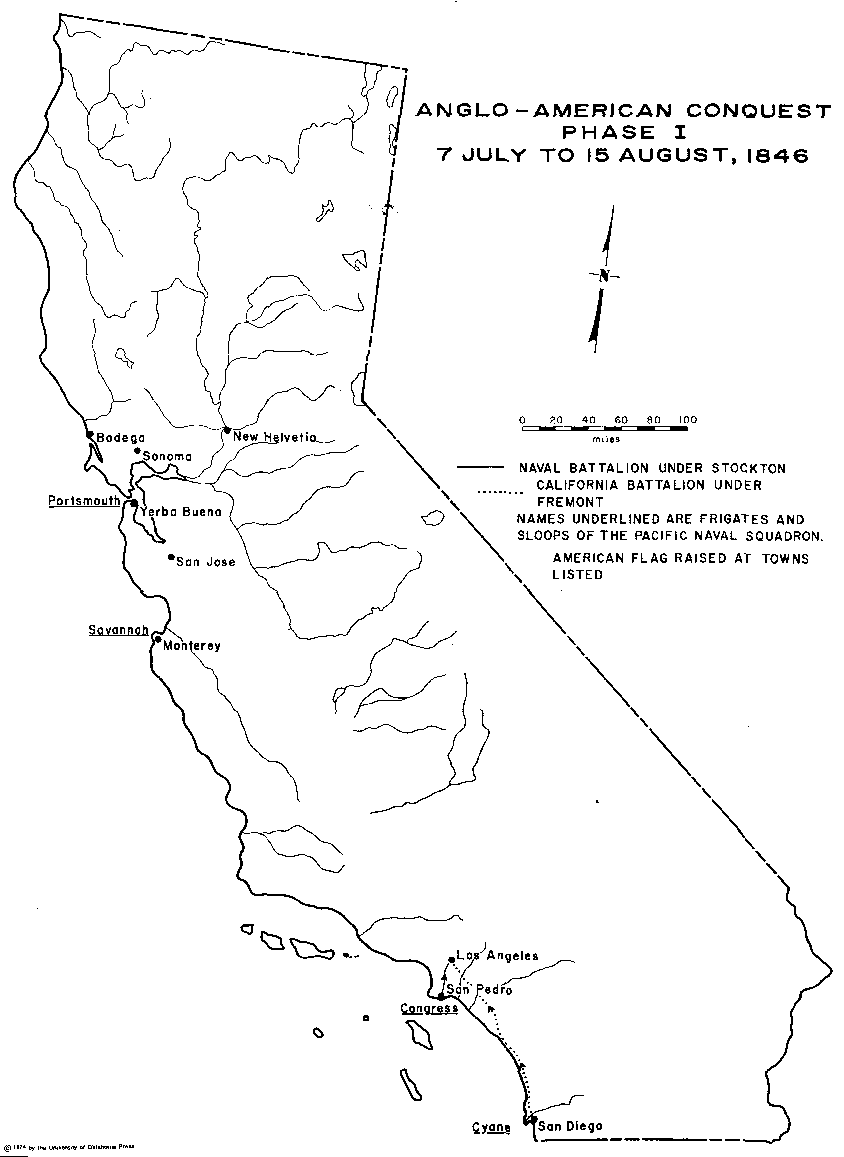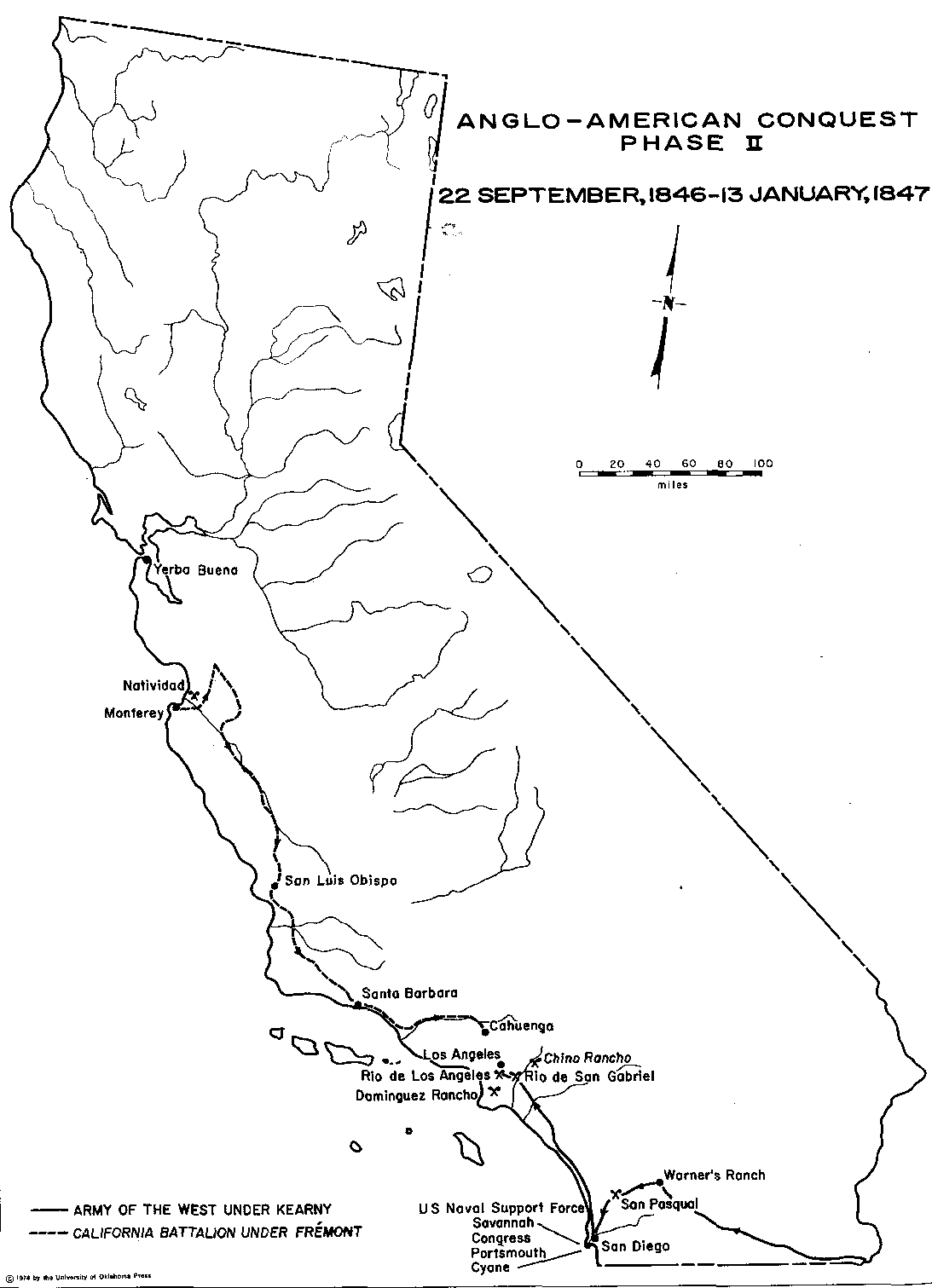
The role of John Charles Fremont in the Bear Flag Revolt remains a matter of controversy. A son-in-law of the influential Missouri Senator, Thomas Hart Benton, and an officer of the elite Army Corps of Topographical Engineers, Fremont had a national reputation by the time of his California adventures. He was greatly aided by the superb prose of his wife, who converted dull military exploratory reports into high adventure which sold widely to a public fascinated by news of the West.
In January, 1844, while returning from an exploratory trip into the Oregon Territory, Fremont went south along the eastern side of the Cascades and the Sierras. In February the explorers' party crossed the deep snow of the Sierra to the welcome hospitality of New Helvetia. After resting for two weeks Fremont and his men went southward through the San Joaquin Valley, over the Tehachapi Pass, and then eastward over the Old Spanish Trail.
The winter of 1845 found Fremont back in California. With a small force the "Pathfinder" entered by way of Truckee Pass. Meanwhile, his main command, under Joseph R. Walker, arrived via the Owens Valley. It took some two months for the two groups to find each other at Rancho Laguna. Mexican authorities, justifiably concerned over the presence of a unit of the United States Army in their territory, ordered Fremont to leave. Instead, the party built fortifications and raised the American flag on Hawk's Peak (or Gavilan, but now called Fremont). After three days Fremont abandoned this site and made his way northward towards the Oregon border. En route he was overtaken by a courier, Lieutenant Archibald H. Gillespie. The Marine Corps officer had traveled across Mexico to California posing as a merchant but carrying special messages from Secretary of State Buchanan to Consul Larkin at Monterey. He showed Fremont a copy of the dispatch to Larkin, as well as a packet of letters from Senator Benton, but historians have speculated that he may also have carried special orders from President Polk.
Fremont's version of the messages he received were vague: "The letter of Senator Benton . . . was a trumpet giving no uncertain note. Read by the light of many conversations and discussions with himself and other governing men in Washington, it clearly made me know that I was required by the Government to find out any foreign schemes in relation to California, and to counteract them so far as was in my power. His letters made me know distinctly that at last the time had come when England must not get a foothold; that we must be first. I was to act, discreetly but positively." In other words, he interpreted his father-in-law's letter as an imperative act in the interests of the United States. In terms of his personal ambitions, Fremont's actions were correct.
While Fremont retraced his steps southward, American settlers started a revolt on their own on June 10, 1846. Hostilities were initiated by seizing a band of horses intended for the Mexican militia. The Bear Flaggers raised the grizzly bear flag and issued a proclamation of independence. A short distance from San Rafael the virtually bloodless "Battle" of Olompali was fought. This action prompted Fre'mont to place his small detachment (sixty-two) of United States troops on the side of the rebels. The question which remains is whether or not Fremont encouraged the revolt. and only waited until success was ensured before overtly joining the conflict. From New Helvetia the small American force made its way to Yerba Buena and on to Monterey, where it joined forces with United States Naval units. The fact that war with Mexico had already begun made Fremont's action acceptable.

While the Bear Flag "Revolt" was in process, preparations for the actual military conquest of California were being made. Commodore John D. Sloat, in command of the Pacific fleet of the United States, heard rumors of the outbreak of war while at Mazatlan, Mexico. Proceeding northward in his flagship USS Savannah, Sloat reached Monterey on July 1 or 2. He waited for several days before taking possession of the city, possibly to make sure that war was an actuality. On July 7, a force of marines and seamen formally raised the United States flag at the customhouse. A conciliatory proclamation was read and posted in public places.
Captain John B. Montgomery of the USS Portsmouth raised the flag at Yerba Buena on July 9, in accordance with Sloat's instructions. On the same day, an aide of Montgomery raised the flag over Sonoma. On July 11, the stars and stripes were also raised at New Helvetia, with so much cannonading that nearly all the glass at Sutter's Fort was broken. In some communities it was the Bear Flag and not that of Mexico which was lowered before the United States flag could be hoisted with proper ceremony.
With the conquest of central California complete, Commodore Sloat turned his command over to Commodore Robert F. Stockton on July 29. The latter naval officer was more belligerent towards the native Californians than his predecessor and was also more eager to complete the conquest of the southern portion of the province. Stockton sailed from Monterey on August 1, planning to capture Los Angeles. Arriving at San Pedro on August 7 with a poorly trained force of 360, he waited until August 11 before beginning the overland march to Los Angeles. Meanwhile, John C. Fremont, who had previously joined forces with Stockton in Monterey, had sailed southward with a battalion. Taking formal possession of San Diego on July 29, Fremont's force marched north on August 8 and joined Stockton in time for the ceremonial flag raising in Los Angeles on August 13.
One American observed that, "we simply marched all over California from Sonoma to San Diego and raised the American flag without opposition or protest. We tried to find an enemy, but could not." There were many reasons for the inability of the native Californians to offer more resistance during the first phase of the American conquest. First of all, California was a remote outpost of Mexico and had been neglected to the point where there was little in the way of a fighting force available or little funds to purchase essential equipment. Hence, many individuals did not want to participate in a useless struggle. Others also were disenchanted with Mexican domination to the point that they were indifferent to the outcome or even favored American victory. Friction between Governor Pio Pico and General Jose Castro also made unity against the invaders difficult. Even if a stubborn resistance had been made, Castro's army seldom exceeded a hundred inferior armed men. On August 10, both Pico and Castro fled Los Angeles for Mexico.

The second phase of the Anglo-American conquest of California saw greater bloodshed than the first phase. Hostilities were renewed on the night of September 22, when the Californios laid siege to the mall American garrison in Los Angeles. On September 26, some twenty Americans, led by Benjamin, surrendered at Chino Rancho. On September 30, the Los Angeles force, commanded by Lieutenant Archibald Gillespie, was permitted to leave for San Pedro with a promise to sail from California. Instead, the American force joined with a relief party and marched inland in in an effort to recapture Los Angeles. On October 9, the Californios defeated the Americans in a battle at Dominguez Rancho, forcing another retreat to San Pedro. This conflict was followed by a temporary cessation of hostilities.
Meanwhile, the army of Stephen Watts Kearny was marching on California. Leaving Fort Leavenworth in June, with a force of more than sixteen hundred men, General Kearny was instructed to capture Santa Fe and California. After a bloodless conquest of New Mexico, Kearny sent most of his troops to aid General Zachary Taylor in Mexico and started for California with only three hundred men. Meeting Kit Carson carrying messages from Stockton to Washington officials relating that the conquest of California had been completed, he sent all but about a hundred of his troops back to Santa Fe. With Carson to guide him, Kearny made the harsh desert crossing, which taxed both men and their mounts.
Near the Indian village of San Pasqual,
Kearny's weary force encountered a detachment of Californios under
Andres Pico. Using exceptionally
poor judgment, the Americans attacked early on the morning of
December 6, despite a cold mist and a fog-shrouded unfamiliar
battlefield. Kearny was urged to immediate battle by Carson and
Gillespie. Wet gunpowder silenced their guns. Mounted on either
worn-out mules or undisciplined horses recently seized from the
Mexicans, the Americans were no match for the lance equipped and
superbly mounted Californios. Kearny's force lost twenty-one killed
and eighteen wounded in the most significant battle on California
soil, while Pico's force had but one fatality and eighteen wounded.
Kit Carson and Lieutenant Edward F. Beale slipped through hostile
country, reached San Diego, and summoned help to the battered
American force.
But San Pasqual was to be the last victory for the Californios. Dissension within their ranks made a strong command impossible. They were further weakened by poor quality gunpowder which reduced the effectiveness of their artillery. On Decem-ber 29 a force of some six hundred Americans under Kearny and Stockton left San Diego overland for Los Angeles. On January 8 there was a brief skirmish on the banks of the Rio de San Gabriel. The following day saw the last battle on California soil. The Californios made their final stand on the banks of the Rio de Los Angeles but withdrew after light artillery fire.
Fremont, in command of the California Battalion,
fought a battle at Natividad in the Salinas Valley, with perhaps
the loss of five lives on each side. The battalion marched southward,
slowed more by mud and rain than by the enemy. On January 13,
1847, the remnants of the command of Andres Pico capitulated to
Fremont at Cahuenga, formally ending hostilities.

 The
U.S.-Mexican War
The
U.S.-Mexican War
 California
Conquered: The Annexation of a Mexican Province, 1846-1850
California
Conquered: The Annexation of a Mexican Province, 1846-1850
 Mr.
Polk's Army: The American Military Experience in the Mexican
War
Mr.
Polk's Army: The American Military Experience in the Mexican
War
 Bear Flag Rising: The Conquest of
California, 1846
Bear Flag Rising: The Conquest of
California, 1846